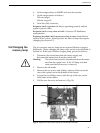
6. Trouble-shooting
6. Trouble-shooting
The UV-1 Monitor has been designed for trouble-free use. If good chromatographic practice is
followed, very little difficulty should be experienced. Clean optical surfaces are essential if low noise
levels are to be maintained. The following check list of the most frequent problems is meant to be a
guide in trouble-shooting. If the checks in this section are executed and the UV-1 still does not work
properly, consult your local GE Healthcare representative.
Symptom
Cause
Remedy
Pilot light does not light 1. Mains cord not plugged in Check that mains cord is plugged in
2. Fuse blown
Replace fuse. If fuse blows again
immediately consult
GE Healthcare representative
3. No voltage at mains socket Check by plugging table lamp in
Pilot light on, no recorder 1.
response
2.
3.
4.
5.
6.
7.
8.
Optical unit not connected
to control unit
Control unit not connected
to recorder
Recorder not operating
Recorder zero not set correctly
Recorder range incorrect
Wrong filter
Filter not pushed in fully
Shutter in place
Check that connecting cable is
plugged in
Check connection between output
terminals and recorder
Check recorder function
Zero recorder
Set recorder range to 10 mV
Check that the filter corresponds to
converter or aperture
Push in filter
Remove shutter and insert converter
or aperture as appropriate
Excessive noise
1.
2.
3.
4.
5.
6.
7.
8.
8.
9.
Poor ground contact
Excess noise on mains supply
Recorder connections
incorrect
Recorder range incorrect
Dirty cell
Deposits on optical surfaces
Solvent with high UV absorption
Lamp not warmed up
Bubbles passing through the cell
Aging lamp
Check contact to ground
Use alternative power source or
remove source of disturbance
Check connection between
output terminals and recorder
Set recorder on 10 mV range
Clean cell
Clean filter and converter
Relocate optical unit in a clean environment
Change to a more suitable solvent
2 h warm-up, in cold room 12 h
De-gas solvent. Check for leaks
Check lamp and replace if necessary
Excessive baseline drift 1.
2.
3.
4.
5.
Variable absorbance gradient
Compensate by use of reference cell
Contaminated solvent Use fresh solvent. Check that plastic tubing
does not leak UV absorbing substances
Large variation in ambient Relocate optical unit or remove
temperature source of temperature change
Instrument warm-up Allow 2 hours warm-up
Condensation forming in
Flush reference cell with dry gas or
empty reference
fill it with the appropriate solvent
Long term noise, 1. Variations in ambient temperature Relocate optical unit or protect
often regular waves in especially in cold room
from draught
recorder reponse
2. Flow rate variations
Check pump system and column packing
3. Poor ground contact Check contact to ground
4. Bubbles passing cell De-gas solvent. Check for leaks
5. Dirty cell
Clean cell
6. Deposits on optical surfaces Clean filter and converter
Relocate optical unit in a clean environment
23


















